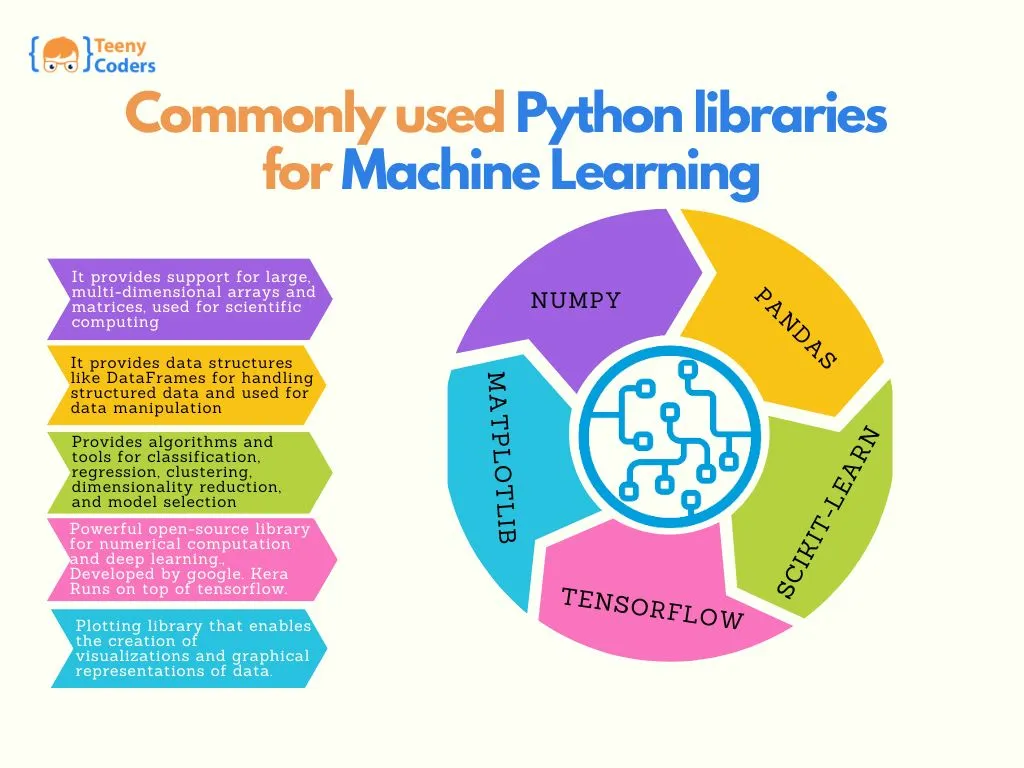Machine learning has become an integral part of various industries, revolutionizing the way we analyze data and make informed decisions. Python, with its simplicity and versatility, has emerged as the go-to programming language for machine learning tasks. Thanks to a rich ecosystem of libraries, Python provides developers with powerful tools to build and deploy machine learning models. In this article, we will explore some commonly used Python libraries for machine learning and highlight their key features and applications.
Table of Contents
Introduction to Python Libraries for Machine Learning
Python libraries provide pre-built functions and modules that simplify the implementation of complex machine learning algorithms. These libraries offer a wide range of capabilities, from numerical computing and data manipulation to data visualization and deep learning. Let’s delve into some of the most popular Python libraries used in the field of machine learning.
NumPy: Foundation for Numerical Computing
NumPy is a fundamental library for scientific computing in Python. It provides support for large, multi-dimensional arrays and matrices, along with a collection of mathematical functions to operate on these arrays efficiently. NumPy forms the foundation for many other Python libraries used in machine learning.
Pandas: Data Manipulation and Analysis
Pandas is a powerful library that offers data manipulation and analysis tools. It provides data structures like DataFrames, which allow for easy handling and processing of structured data. With Pandas, you can clean, transform, and analyze data, making it an essential tool for any machine learning project.
Matplotlib: Data Visualization Made Easy
Matplotlib is a popular data visualization library in Python. It enables the creation of a wide range of charts, plots, and graphs, helping researchers and data scientists visualize their data effectively. Matplotlib integrates seamlessly with other libraries, making it an indispensable tool for visualizing machine learning results.
Scikit-learn: Essential Machine Learning Toolkit
Scikit-learn is a comprehensive library that provides a wide range of machine learning algorithms and tools. It offers implementations of various supervised and unsupervised learning algorithms, as well as tools for model selection, evaluation, and preprocessing. Scikit-learn simplifies the process of developing and deploying machine learning models.
TensorFlow: Deep Learning Framework
TensorFlow is a powerful open-source library for deep learning. It enables the creation of neural networks and facilitates their training on both CPUs and GPUs. TensorFlow offers a flexible architecture and extensive support for deep learning tasks, making it a popular choice among researchers and practitioners.
Keras: High-Level Neural Networks API
Keras is a high-level neural networks API that runs on top of TensorFlow. It provides an intuitive and user-friendly interface for building and training deep learning models. Keras abstracts away the complexities of TensorFlow, allowing developers to focus on model design and experimentation.
PyTorch: Deep Learning with Dynamic Computation Graphs
PyTorch is another popular deep learning framework that emphasizes flexibility and dynamic computation graphs. It offers a seamless experience for researchers and developers, providing tools for building and training neural networks. PyTorch’s dynamic nature makes it ideal for tasks that involve complex and evolving architectures.
XGBoost: Extreme Gradient Boosting
XGBoost is a gradient boosting library that excels in handling structured data and achieving high prediction accuracy. It implements an optimized gradient boosting algorithm, which combines the predictions of multiple weak models to create a strong predictive model. XGBoost has been widely used in winning solutions of machine learning competitions.
LightGBM: High-Performance Gradient Boosting
LightGBM is another gradient boosting library that focuses on performance and efficiency. It leverages histogram-based algorithms to speed up the training process and achieve high accuracy with large datasets. LightGBM is particularly effective in scenarios with limited computational resources.
OpenCV: Computer Vision and Image Processing
OpenCV is a powerful library for computer vision and image processing tasks. It provides a wide range of functions and algorithms for image and video manipulation, feature extraction, object detection, and more. OpenCV is extensively used in machine learning applications that involve visual data.
NLTK: Natural Language Processing
NLTK (Natural Language Toolkit) is a library for natural language processing tasks. It offers a comprehensive suite of text processing libraries and corpora, along with a wide range of algorithms for tasks such as tokenization, stemming, tagging, and parsing. NLTK is a valuable tool for building text-based machine learning models.
SpaCy: Advanced Natural Language Processing
SpaCy is another popular library for natural language processing. It provides efficient and scalable implementations of common NLP tasks, such as part-of-speech tagging, named entity recognition, and dependency parsing. SpaCy’s focus on performance makes it suitable for large-scale NLP pipelines.
Statsmodels: Statistical Modeling and Testing
Statsmodels is a library that focuses on statistical modeling and hypothesis testing. It provides a comprehensive set of tools for exploring and analyzing data, estimating statistical models, and performing statistical tests. Statsmodels is widely used in statistical research and the social sciences.
Conclusion
Python’s extensive library ecosystem plays a vital role in making it the preferred programming language for machine learning. The libraries mentioned in this article, such as NumPy, Pandas, Matplotlib, Scikit-learn, TensorFlow, and many others, provide developers with a wide range of tools and functionalities to tackle various machine learning tasks. By leveraging these libraries, researchers and data scientists can accelerate the development and deployment of machine learning models.


